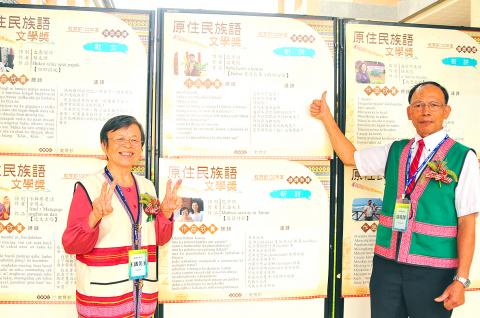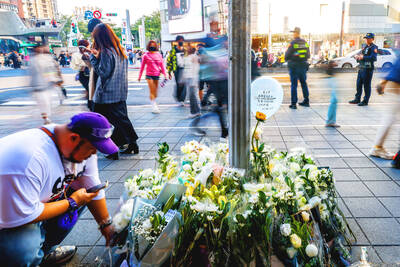Two Pazeh Aboriginal writers were honored by the Ministry of Education with awards at an event in Hualien County on Friday for their efforts to revive and preserve their critically endangered language, which they said has been a very difficult task because the government does not officially recognize their people.
Award recipients Pan Ying-chieh (潘英傑) and Wang Pan Mei-yu (王潘美玉) are relatives from the Pazeh family clan, from the Ailan area (愛蘭) of Nantou County’s Puli (埔里).
Pazeh is one of Taiwan’s 10 Pingpu Aborigine groups, also known as lowland Aborigines. They say their language, culture and ethnic identity are disappearing because they are excluded from the benefits of official government recognition enjoyed by the nation’s 14 Aboriginal peoples.

Photo: Hua Meng-ching, Taipei Times
Pan Ying-chieh said the Pazeh family clans in Puli have organized an association to promote their culture and to resuscitate the language, with seminars and classes being held at the local Ailan Presbyterian Church on weekends and during holidays.
“Our people decided that we must do this, because our mother tongue is nearing extinction, with just a few elderly speakers still using the language. It is like a patient dying in a hospital emergency ward, with doctors and families trying their best to save its life,” he said.
Pan, 66, said Pazeh is listed by the UN as one of 18 critically endangered languages in the world, with only a few native speakers.
He said he is very disappointed at the government’s continual denial of the existence of the Pazeh Aboriginal people and their language, which belongs to the Austronesian linguistic family of the Pacific Islands and Southeast Asian regions.
Wang Pan, 81, has lived in Puli’s Ailan area for most of her life. The town is one of only three remaining towns in Taiwan with a native Pazeh population. There are only a few thousand Pazeh Aborigines left.
“I learned the Pazeh language during my childhood, but most of the time I spoke Hoklo [also known as Taiwanese]. This is because in those times Taiwanese society was prejudiced and looked down on us Pingpu Aborigines. Other people called us “fan” [番, a derogatory label for Aborigines]. Because of this discrimination, I did not learn our Pazeh language well,” she said.
She again started learning the language in 2007, when Pazeh elders organized weekly seminars and classes in order to preserve their culture, save their mother tongue from dying out and passing their customs on to the younger generations.
Due to her childhood familiarity with the language, Wang Pan advanced rapidly and became a Pazeh language teacher herself. She now presents classes to young people.
Wang Pan said the main reason for writing in Pazeh and competing for the ministry’s language awards is to make the government and the public aware of the Pazeh people’s determined efforts to revive their culture, and to save their dying language.
Pan Ying-chieh said that several members of their Pazeh community are writing literature, poems and narrative stories in the Pazeh language, using the romanized alphabet system that is used by all of Taiwan’s Aboriginal writers.
“This year we had five members eligible for the ministry’s awards for Aboriginal literature. We were excluded from participating last year, because the government does not recognize the existence of the Pazeh language,” Pan said.
He said the Pazeh Aborigines collectively applied to the Council of Indigenous Peoples in 2006 for restoration of their original “Indigenous” status, which they had held in the household registry system along with the Gaoshan, or highland Aborigine groups, during the Japanese colonial era and up to the 1950s during the then-Chinese Nationalist Party (KMT) administration.
“Despite our repeated efforts and lobbying the government, we are to this day still excluded and not recognized as an Aborigine group,” he said, “In any case, we will continue our efforts to save our Pazeh culture and language.”

Beijing could eventually see a full amphibious invasion of Taiwan as the only "prudent" way to bring about unification, the US Department of Defense said in a newly released annual report to Congress. The Pentagon's "Annual Report to Congress: Military and Security Developments Involving the People's Republic of China 2025," was in many ways similar to last year’s report but reorganized the analysis of the options China has to take over Taiwan. Generally, according to the report, Chinese leaders view the People's Liberation Army's (PLA) capabilities for a Taiwan campaign as improving, but they remain uncertain about its readiness to successfully seize

HORROR STORIES: One victim recounted not realizing they had been stabbed and seeing people bleeding, while another recalled breaking down in tears after fleeing A man on Friday died after he tried to fight the knife-wielding suspect who went on a stabbing spree near two of Taipei’s busiest metro stations, Taipei Mayor Chiang Wan-an (蔣萬安) said. The 57-year-old man, identified by his family name, Yu (余), encountered the suspect at Exit M7 of Taipei Main Station and immediately tried to stop him, but was fatally wounded and later died, Chiang said, calling the incident “heartbreaking.” Yu’s family would receive at least NT$5 million (US$158,584) in compensation through the Taipei Rapid Transit Corp’s (TRTC) insurance coverage, he said after convening an emergency security response meeting yesterday morning. National

Taiwan has overtaken South Korea this year in per capita income for the first time in 23 years, IMF data showed. Per capita income is a nation’s GDP divided by the total population, used to compare average wealth levels across countries. Taiwan also beat Japan this year on per capita income, after surpassing it for the first time last year, US magazine Newsweek reported yesterday. Across Asia, Taiwan ranked fourth for per capita income at US$37,827 this year due to sustained economic growth, the report said. In the top three spots were Singapore, Macau and Hong Kong, it said. South

PLANNED: The suspect visited the crime scene before the killings, seeking information on how to access the roof, and had extensively researched a 2014 stabbing incident The suspect in a stabbing attack that killed three people and injured 11 in Taipei on Friday had planned the assault and set fires at other locations earlier in the day, law enforcement officials said yesterday. National Police Agency (NPA) Director-General Chang Jung-hsin (張榮興) said the suspect, a 27-year-old man named Chang Wen (張文), began the attacks at 3:40pm, first setting off smoke bombs on a road, damaging cars and motorbikes. Earlier, Chang Wen set fire to a rental room where he was staying on Gongyuan Road in Zhongzheng District (中正), Chang Jung-hsin said. The suspect later threw smoke grenades near two exits